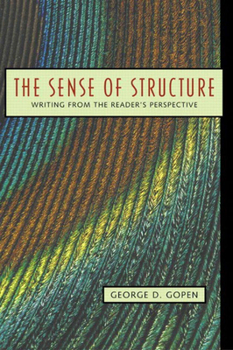The Sense of Structure: Writing from the Reader's Perspective
Emphasizing "reader expectations," this composition text provides an insightful guide to writing clearly and effectively. Reflecting on the author's decades of experience as an international writing consultant, writer, and instructor, The Sense of Structure teaches writing from the perspective of readers. This text demonstrates that readers have relatively fixed expectations of where certain words or grammatical constructions will appear in a unit of discourse. By bringing these intuitive reading processes to conscious thought, this text provides students with tools for understanding how readers interact with the structure of writing, from punctuation marks to sentences to paragraphs, and how meaning and purpose are communicated through structure.
Format:Paperback
Language:English
ISBN:0205296327
ISBN13:9780205296323
Release Date:January 2004
Publisher:Pearson
Length:256 Pages
Weight:0.79 lbs.
Dimensions:0.6" x 5.9" x 8.8"
Customer Reviews
5 ratings
the antidote to "style checking software"
Published by Thriftbooks.com User , 16 years ago
This book should be read by anyone who teaches writing, and certainly anyone teaching academic writing, since the more complex the writing, the more important the reader-centred editing strategies in this book become. Both native and nonnative English speakers hearing the principles described in this book tend to exclaim "WHY didn't someone tell me this before???" (For a quick runthrough of some of them, Google Gopen & Swan's classic article, "The Science of Science Writing") I teach writing to (mainly nonnative English speaking) postgraduates and postdoctoral scientists. I use my own (draft) textbook, nearly finished before I read this book, but often people want additional reading and exercises. The problem is, there is a lot of published and accepted bad advice about writing. Really a lot. This book is one of the very few I recommend. Right now, I see two genuinely helpful books for students on the market. _The Sense of Structure_ is one of them, and Williams & Colomb's _the Craft of Argument_ is the other. PhD students should consider forming small groups to work through these two books, trying and discussing the exercises, then applying the principles to their own writing. I have only two gripes with this book. First, the pages are too cramped, leaving no space for marginal notes. There is so MUCH information in so little space. Second, Gopen makes a throwaway comment that these rules can become part of every good writer's writing process. That could be very discouraging as a goalThe Craft of Argument: Concise. Instead, think of multiple drafts: writing what you mean to say if difficult in its own right, so planning and creating a first draft would be a first step. Then getting others to understand that draft -- that's where the principles in this book are essential. Yes, over time some of them will creep into first drafts, but making that into a goal is making the whole process of writing more complex. First write it down, then "write it up". This is THE book about how to do the latter.
Highly recommended to graduate students, professors, and related professionals!
Published by Thriftbooks.com User , 17 years ago
This is by far the best book I've ever read about stylistic writing. It really makes you aware of how your readers interpret your writing; hence, allowing you to make more effective use of words, puntuations, etc. to clearly convey your thoughts and findings...
The Sense of Structure: Writing from the Reader's Perspective
Published by Thriftbooks.com User , 18 years ago
This is an outstanding book that is "must' reading for anyone doing serious writing. It opens one's eyes to the subtleties of writing for the reader. Dr. Gopen stresses the importance of writing to the reader; writing to their expectations. He then carefully goes through all aspects of what readers of English expect and the reasons why. He then tells writers how to take advantage of these expectations to produce prose that is easy to understand and gets your point or arguments across crisply.
great, pratical writing advice
Published by Thriftbooks.com User , 19 years ago
This is a great book. Reading it, and applying its lessons has really helped my writing become more clear and understandable. I have gained a new vocabularly for talking about writing, one which makes editing conversations much more sensible than simply "I think it sounds better like..."
The best book on writing English extant
Published by Thriftbooks.com User , 20 years ago
The author, George Gopen, is a professor of rhetoric and a consultant to many firms about writing. Gopen presents a different approach to writing---one that focuses on what a reader is likely to glean from your writing. Thus, he assumes you are writing to communicate with another person, rather than simply to please yourself. If this is true, and it almost always will be, then Gopen's techniques cannot be bested. He concentrates on "tools, not rules," with the paramount concern being whether the reader is likely to understand the writer's intention. His techniques are largely structural, based on current research into how readers of English read. His techniques, moreover, are objective, which solves the problem of how to edit your own work so that it will mean to a reader what it means to you. Gopen also provides practical tips on how to structure both sentences and paragraphs for proper emphasis. He demonstrates how to manipulate the story being told to ensure the reader is not left in the dark about what is being communicated. He concludes with a non-dogmatic guide to punctuation and grammatical tools, designed to improve communication under various circumstances. To learn the specific techniques, read Gopen's book. I assure you that you will never have encountered a better approach to writing.





